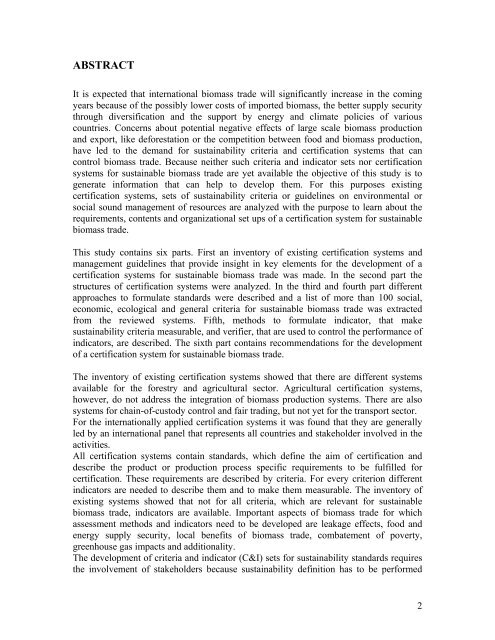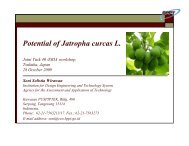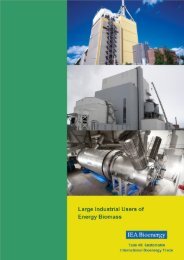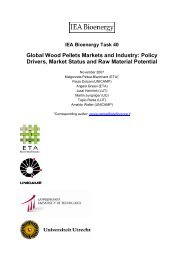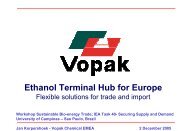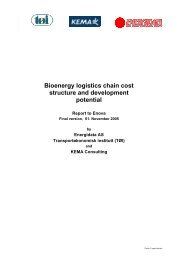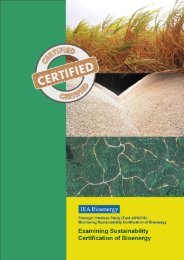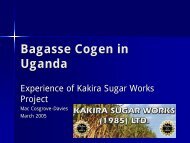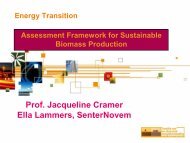steps towards the development of a certification system for ...
steps towards the development of a certification system for ...
steps towards the development of a certification system for ...
Create successful ePaper yourself
Turn your PDF publications into a flip-book with our unique Google optimized e-Paper software.
ABSTRACTIt is expected that international biomass trade will significantly increase in <strong>the</strong> comingyears because <strong>of</strong> <strong>the</strong> possibly lower costs <strong>of</strong> imported biomass, <strong>the</strong> better supply securitythrough diversification and <strong>the</strong> support by energy and climate policies <strong>of</strong> variouscountries. Concerns about potential negative effects <strong>of</strong> large scale biomass productionand export, like de<strong>for</strong>estation or <strong>the</strong> competition between food and biomass production,have led to <strong>the</strong> demand <strong>for</strong> sustainability criteria and <strong>certification</strong> <strong>system</strong>s that cancontrol biomass trade. Because nei<strong>the</strong>r such criteria and indicator sets nor <strong>certification</strong><strong>system</strong>s <strong>for</strong> sustainable biomass trade are yet available <strong>the</strong> objective <strong>of</strong> this study is togenerate in<strong>for</strong>mation that can help to develop <strong>the</strong>m. For this purposes existing<strong>certification</strong> <strong>system</strong>s, sets <strong>of</strong> sustainability criteria or guidelines on environmental orsocial sound management <strong>of</strong> resources are analyzed with <strong>the</strong> purpose to learn about <strong>the</strong>requirements, contents and organizational set ups <strong>of</strong> a <strong>certification</strong> <strong>system</strong> <strong>for</strong> sustainablebiomass trade.This study contains six parts. First an inventory <strong>of</strong> existing <strong>certification</strong> <strong>system</strong>s andmanagement guidelines that provide insight in key elements <strong>for</strong> <strong>the</strong> <strong>development</strong> <strong>of</strong> a<strong>certification</strong> <strong>system</strong>s <strong>for</strong> sustainable biomass trade was made. In <strong>the</strong> second part <strong>the</strong>structures <strong>of</strong> <strong>certification</strong> <strong>system</strong>s were analyzed. In <strong>the</strong> third and fourth part differentapproaches to <strong>for</strong>mulate standards were described and a list <strong>of</strong> more than 100 social,economic, ecological and general criteria <strong>for</strong> sustainable biomass trade was extractedfrom <strong>the</strong> reviewed <strong>system</strong>s. Fifth, methods to <strong>for</strong>mulate indicator, that makesustainability criteria measurable, and verifier, that are used to control <strong>the</strong> per<strong>for</strong>mance <strong>of</strong>indicators, are described. The sixth part contains recommendations <strong>for</strong> <strong>the</strong> <strong>development</strong><strong>of</strong> a <strong>certification</strong> <strong>system</strong> <strong>for</strong> sustainable biomass trade.The inventory <strong>of</strong> existing <strong>certification</strong> <strong>system</strong>s showed that <strong>the</strong>re are different <strong>system</strong>savailable <strong>for</strong> <strong>the</strong> <strong>for</strong>estry and agricultural sector. Agricultural <strong>certification</strong> <strong>system</strong>s,however, do not address <strong>the</strong> integration <strong>of</strong> biomass production <strong>system</strong>s. There are also<strong>system</strong>s <strong>for</strong> chain-<strong>of</strong>-custody control and fair trading, but not yet <strong>for</strong> <strong>the</strong> transport sector.For <strong>the</strong> internationally applied <strong>certification</strong> <strong>system</strong>s it was found that <strong>the</strong>y are generallyled by an international panel that represents all countries and stakeholder involved in <strong>the</strong>activities.All <strong>certification</strong> <strong>system</strong>s contain standards, which define <strong>the</strong> aim <strong>of</strong> <strong>certification</strong> anddescribe <strong>the</strong> product or production process specific requirements to be fulfilled <strong>for</strong><strong>certification</strong>. These requirements are described by criteria. For every criterion differentindicators are needed to describe <strong>the</strong>m and to make <strong>the</strong>m measurable. The inventory <strong>of</strong>existing <strong>system</strong>s showed that not <strong>for</strong> all criteria, which are relevant <strong>for</strong> sustainablebiomass trade, indicators are available. Important aspects <strong>of</strong> biomass trade <strong>for</strong> whichassessment methods and indicators need to be developed are leakage effects, food andenergy supply security, local benefits <strong>of</strong> biomass trade, combatement <strong>of</strong> poverty,greenhouse gas impacts and additionality.The <strong>development</strong> <strong>of</strong> criteria and indicator (C&I) sets <strong>for</strong> sustainability standards requires<strong>the</strong> involvement <strong>of</strong> stakeholders because sustainability definition has to be per<strong>for</strong>med2


